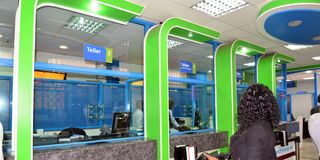
A customer being served at the Transnational Bank branch along City Hall Way in Nairobi. PHOTO | FILE | NMG
Commercial banks have increased interest on deposits to levels last seen 23 years ago to attract savers who are faced with attractive returns from other asset classes including government paper in the wake of three rises in the benchmark lending rates within a year.
Data from the Central Bank of Kenya (CBK) shows banks closed October with an average deposit rate of 9.11 percent in October from the previous month’s 8.39 percent, marking 12 straight months of increasing returns on deposits for savers.
At 9.11 percent, bank savers are enjoying the highest rates since February 2000 when it was at 9.17 percent and raises optimism of double digit returns in the new year especially after the CBK in early December raised the Central Bank Rate (CBR) from 10.5 percent to an 11-year high of 12.5 percent.
The rising returns on deposits have come in the period that returns on Treasury bills and bonds have also been rising, giving savers an option to invest in such asset classes and lift their returns.
The return from 91-day, 182-day and 364-day Treasury bills averaged 15.88 percent, 15.97 percent and 15.9 percent respectively in the auction held on December 21. The same papers fetched 9.39 percent, 9.85 percent and 10.37 percent in the first auction of the year on January 5, 2023.
Commercial banks usually offer a premium to customers locking in deposits for a specified period with the deposits serving to form the lenders’ funding base which is then primarily deployed in lending activities.
CBK data shows non-fixed deposit savers however saw their return drop to 3.98 percent in October from 4.05 percent, revealing the difference in returns between those who save on a short-term basis and those willing to lock their money for a relatively longer period.
Deposits are banks’ primary source of funding loan book and a rise in interest on deposits is usually accompanied by a rise in the interest rate on loans.
CBK data shows average base lending rates among banks rose from 13.24 percent to 14.09 percent in October, marking the fourth straight month of loans becoming more expensive.
At 14.09 percent, the average base rates are at their highest in seven years, only dwarfed by the 17.96 percent that was in place in August 2016 —a month before the government started applying the now abolished interest rate cap law.
The CBK has in 2023 raised the CBR rate thrice —in March, June and December—representing a 3.75 percentage points increase to 12.5 percent from 8.75 percent at the start of the year.
This has been translating to an increase in the cost of loans, with the latest round having set in. Equity Bank raised its reference rate from 14.69 percent to 17.56 percent while that of NCBA Bank moved from 14.5 percent to 16.5 percent. KCB Bank Kenya has also adjusted its base rate from 13.8 percent to 14.7 percent.
The increased interest rates have served a setback to borrowers through increased monthly deductions to service their loans. Those not willing to pay more per month have had to renegotiate their loans into longer repayment periods.







